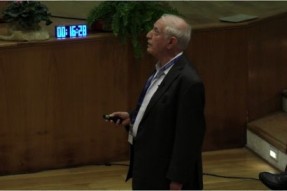Rare nuclear decays are a promising search channel for new hidden particle species with masses near the MeV scale. Recently, we measured the e+e− angular correlation in internal pair creation for the M1 transition depopulating the 18.15 MeV isoscalar 1+ state in 8Be, and observed a peak-like deviation from the predicted IPC.
To the best of our knowledge no nuclear physics related description of such deviation can be made. The deviation between the experimental and theoretical angular correlations is significant and can be described by assuming the creation and subsequent decay of a boson with mass: m0c2= 16.70 ± 0. 35(stat) ± 0. 5(sys) MeV. The branching ratio of the e+e− decay of such a boson to the γ decay of the 18.15 MeV level of 8Be is found to be 5. 8x10-6 for the best fit. We have also investigated the similar 17.65 MeV 1+ 0+ M1 transition in 8Be, which has isovector character, but no deviation was observed. The data can be explained by a 17 MeV vector gauge boson X that is produced in the decay of the excited state to the ground state, and then decays to e+e− pairs. The X boson would mediate a fifth force with a characteristic range of 12 fm and would have millicharged couplings to up and down quarks and electrons, and a proton coupling that is suppressed relative to neutrons [3]. More recently, Kozarczuk et al., [4] have studied such an interpretation for a light vector boson with axial couplings to quarks. They have performed a detailed ab initio calculation of the relevant nuclear transition matrix elements. They find that such a vector boson can account for the anomaly provided it has a mass of mx ≃ 17 MeV and axial couplings to quarks on the order of 10-5 – 10-4. Relative to vector bosons with exclusively vector couplings to quarks, the axial interpretation provides a natural suppression of vector emission in the isovector 17.65 MeV transition, where no anomaly is seen.
In order to clarify the interpretation, recently we reinvestigated the anomaly observed previously by using a new Tandetron accelerator of our Institute. The multi-wire proportional counters were replaced with silicon DSSD detectors, as well as the complete electronics and data acquisition system was changed from CAMAC to VME. We have measured the e+e− angular correlations in internal pair creation for the M1 transitions depopulating the 17.64 MeV and 18.15 MeV 1+ states in 8Be, and observed a definite peak-like deviation from the predicted IPC only for the 18.15 MeV transition. I am going to speak about our most recent results and plans, as well as the possible interpretations of the results.
A.J. Krasznahorkay, M. Csatlós, L. Csige, J. Gulyás, M. Hunyadi, I. Kuti, Á. Nagy, B.M. Nyakó, N. Sas, J. Timár, I. Vajda Institute for Nuclear Research, Hungarian Academy of Sciences, MTA Atomki T.J. Ketel Nikhef National Inst. for Subatomic Physics, Science Park 105, 1098 XG Amsterdam, The Netherlands A. Krasznahorkay CERN, Geneva, Switzerland
"CNNP 2017 - Conference on Neutrino and Nuclear Physics" (Catania, 15-21 October 2017)
Vedi anche
- Bellezze e sporcizia nell'Universo
- Simmetria: la ricerca di ordine in natura
- Structure of proton-rich nuclei via mirror beta decay and charge exchange reactions
- Developments and applications of Micro-Pattern Gaseous Detectors (MPGD): a concise review
- Novel approaches to the nuclear physics of double beta decay
- DAMA/LIBRA results and perspectives
- The SOX experiment at LNGS for the search of sterile neutrinos
- The HALO and HALO-1kT Supernova Detectors
- Low-energy neutrino experiment at Jinping
- Theory of neutrino masses and mixing










































